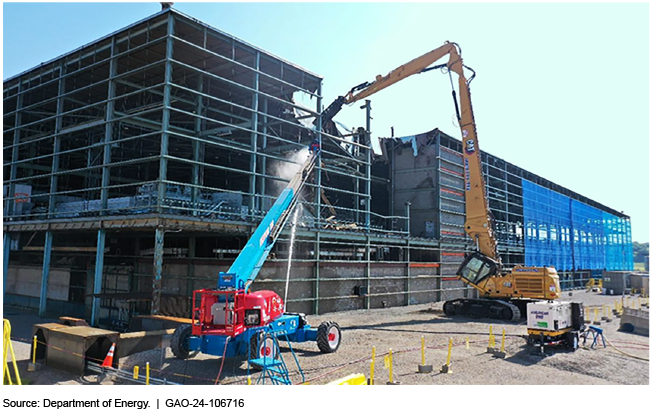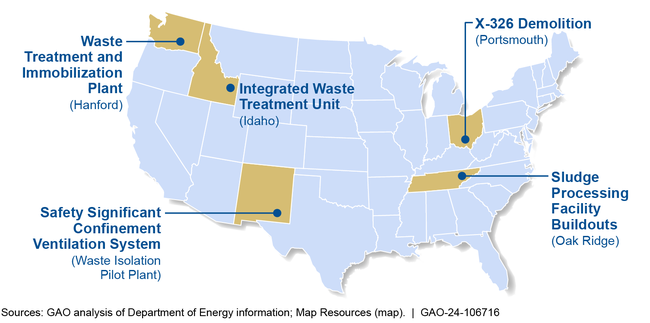Nuclear Waste Cleanup: More Effective Oversight Is Needed to Help Ensure Better Project Outcomes
Fast Facts
The Department of Energy is responsible for treating and disposing of waste from nuclear weapons production and energy research. Its projects for building treatment facilities and demolishing old buildings have often been over budget and delayed.
DOE project management has been on our High Risk List since 1990.
We reviewed DOE oversight of 5 contracted projects. In the only project ahead of schedule and under budget, contractors maintained consistent, reliable project data in systems that oversight officials could use to find problems promptly.
We recommended ensuring contractors maintain good project data systems, and more.
Demolition Project at the Portsmouth site in Ohio

Highlights
What GAO Found
The Department of Energy (DOE) has a range of policies that seek to ensure it produces quality products and services, including capital asset projects. Further, DOE's Office of Environmental Management (EM) uses several tools to oversee quality assurance on its capital asset projects. These include sharing lessons learned and using contractor data to monitor project performance.
GAO reviewed five selected EM capital asset projects and found that for three projects with cost overruns and schedule delays, officials did not use certain quality assurance oversight processes as intended. For example, two projects did not have consistently compliant Earned Value Management Systems. These systems help measure cost and schedule performance and can alert officials to problems. Conversely, GAO found that one project that was performing ahead of schedule and under budget had a consistently compliant system.
Names and Locations of Selected Office of Environmental Management Capital Asset Projects

DOE has not always demonstrated a commitment to addressing the underlying causes of quality assurance issues to prevent recurrence. GAO found that EM does not consistently assess the effectiveness of its contractor oversight or identify root causes of project deficiencies related to EM's management. For example, in a 2021 root cause analysis, EM did not acknowledge its role in hiring an inexperienced contractor and not providing sufficient oversight. GAO also found that EM does not have guidance for assessing federal management performance or oversight effectiveness. By providing project review guidance for identifying management's role in project deficiencies and analyzing the effectiveness of federal oversight, DOE can help prevent recurring problems.
Further, many of EM's project reviews rely on contractors' Earned Value Management Systems data. However, DOE has allowed some contractors to operate their systems with deficiencies for years, which may result in undependable data. By holding contractors accountable for maintaining quality earned value management data, DOE will be better positioned to oversee contractor performance and ensure quality capital asset projects.
Why GAO Did This Study
EM is responsible for treatment and disposal of radioactive and hazardous waste generated in nuclear weapons production and energy research. One way EM fulfills its mission is through capital asset projects, which are generally executed by contractors. These projects include construction of new facilities to treat radioactive waste and demolition of old facilities. In the last decade, DOE's Office of Inspector General and GAO have reported on quality assurance issues on capital asset projects that have also had cost and schedule issues.
House Report 117-397 includes a provision for GAO to review EM's current quality assurance functions for capital asset projects. This report (1) describes how DOE and EM oversee quality assurance on these projects, (2) examines how use of oversight processes may have affected the performance of five selected EM projects, and (3) assesses DOE's actions to ensure quality assurance issues on EM capital asset projects do not recur. GAO reviewed DOE and EM oversight policies and project documentation for five capital asset projects ranging from $160 million to $18.5 billion in total estimated costs and interviewed DOE officials.
Recommendations
GAO is making four recommendations, including that (1) EM develop project review guidance for analyzing federal management performance and oversight effectiveness, and (2) DOE evaluate options to hold contractors accountable for maintaining compliant Earned Value Management Systems. DOE concurred with GAO's recommendations.
Recommendations for Executive Action
| Agency Affected | Recommendation | Status |
|---|---|---|
| Department of Energy | The Secretary of Energy should ensure that the Senior Advisor for the Office of Environmental Management develops or updates relevant guidance for conducting project reviews—including root cause analyses—for EM capital asset projects to include steps for analyzing federal management performance and oversight effectiveness. (Recommendation 1) |
In a January 2025 letter, DOE stated that it will establish a standard operating procedure for root cause analysis and development of corrective action plans. The agency has also initiated updates and revisions to its standard operating procedure for project peer reviews and independent project reviews to evaluate federal management performance and oversight effectiveness. Officials also provided us with a draft of the standard operating procedure for root cause analysis. Based on our analysis of the draft document, it does not include specific steps for analyzing federal management performance and oversight effectiveness. We will continue to monitor progress on this recommendation.
|
| Department of Energy |
Priority Rec.
The Secretary of Energy should ensure that the Senior Advisor for the Office of Environmental Management works with the Director of the Office of Project Management to leverage existing mechanisms to hold applicable contractors accountable for maintaining a compliant EVMS, evaluate if additional mechanisms are needed to hold contractors accountable—such as withholding payment if an EVMS is not compliant—and, if necessary, request authority from Congress to use those mechanisms. (Recommendation 2) |
DOE agreed with our recommendation. As of January 2025, EM worked with the Director of the Office of Project Management to evaluate whether additional mechanisms are needed to hold contractors accountable for maintaining a compliant EVMS. EM determined that its existing mechanisms were sufficient. However, DOE has not yet provided information on how they are leveraging existing mechanisms to hold current contractors accountable. Fully implementing the recommendation will allow DOE to hold contractors accountable for maintaining quality earned value management data. Taking such actions will better position DOE to oversee contractor performance and ensure quality in capital asset projects.
|
| Department of Energy | The Secretary of Energy should ensure that the Senior Advisor for the Office of Environmental Management evaluates how EM capital asset project officials develop and use lessons learned to determine if new lessons learned are being adequately documented and existing lessons learned are being adequately reviewed, analyzed, and applied, or if further guidance is needed. (Recommendation 3) |
In a January 2025 letter, DOE stated that the Office of Environmental Management has initiated updates and revisions to its standard operating procedures for project peer reviews to evaluate if lessons learned are being adequately documented and existing lessons learned are being adequately reviewed, analyzed, and applied. DOE officials also provided us with a draft copy of the standard operating procedure. Based on our review, the revisions will address the portion of the recommendation to evaluate if existing lessons learned are being used adequately, but the revisions do not address the portion of the recommendation to evaluate if new lessons learned are being adequately documented or to evaluate if additional guidance is needed. We will continue to monitor implementation of this recommendation.
|
| Department of Energy | The Senior Advisor for the Office of Environmental Management should ensure that the Director of EM's Office of Project Management develops a process to determine if EM capital asset projects that meet certain criteria—such as those that are particularly high risk or complex—need additional proactive federal oversight from the beginning of the project's lifecycle. (Recommendation 4) |
In a January 2025 letter, DOE stated that the Office of Environmental Management would incorporate a process to evaluate if capital asset projects that meet certain criteria need additional proactive federal oversight from the beginning of the project's lifecycle into the standard operating procedure for critical decision approval. DOE also provided us with a draft version of the updated standard operating procedure. Based on our review of the standard operating procedure, the revised draft appears to meet the full intent of the recommendation. It includes clarification of the types of projects that are more likely to need additional oversight as well as information on what that additional oversight will be. It also notes that additional oversight requirements can be triggered by concerns noted during the initial review of the first critical decision package. DOE officials told us they plan to finalize the draft procedure in March 2025. We will continue to monitor implementation of this recommendation.
|
